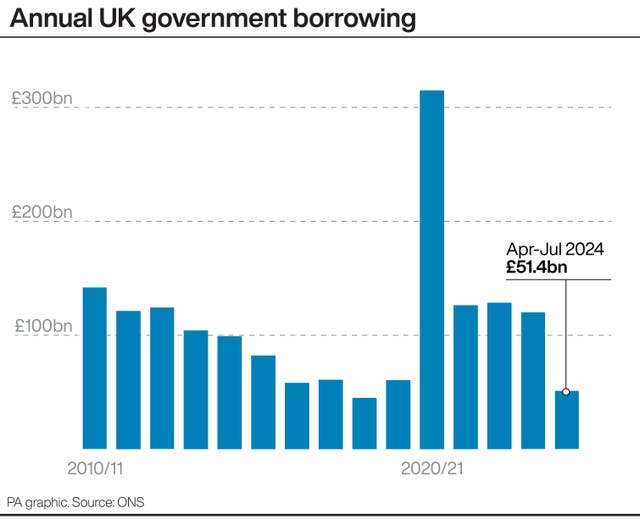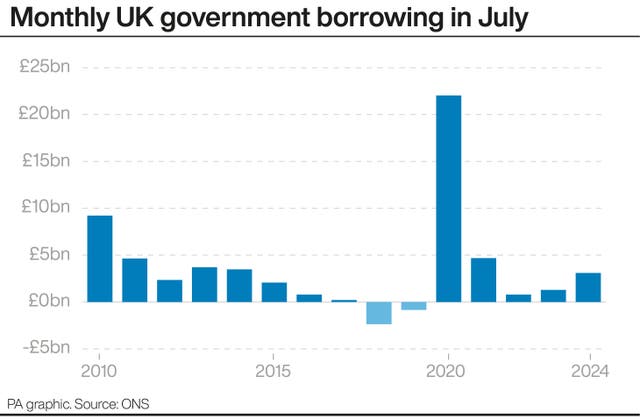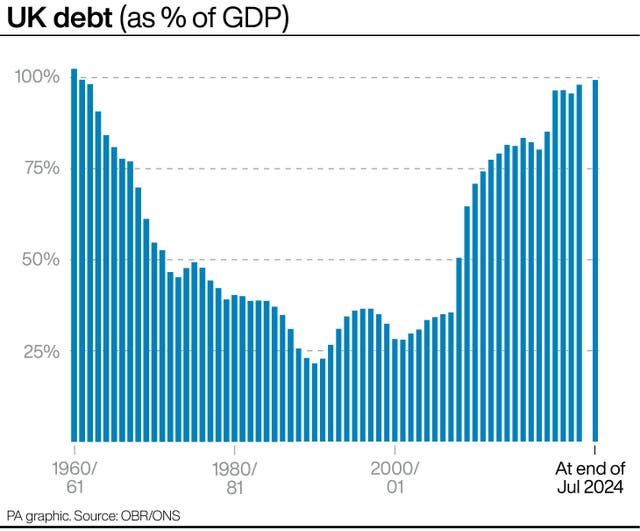
Tom Swarbrick 4pm - 6pm
21 August 2024, 13:44

The Office for National Statistics (ONS) said public sector net borrowing stood at £3.1 billion last month, £1.8 billion more than in July last year.
Chancellor Rachel Reeves is facing further challenges ahead of her first Budget this autumn after official figures revealed government borrowing jumped by far more than expected last month.
The Office for National Statistics (ONS) said public sector net borrowing stood at £3.1 billion last month – £1.8 billion more than a year ago and the highest July borrowing since 2021.
The total for July was £3 billion more than predicted by Britain’s official forecaster, the Office for Budget Responsibility (OBR), and higher than the £1.1 billion most economists were pencilling in.
Borrowing in the financial year from the end of March to July was £51.4 billion, £500 million less than in the same four-month period a year earlier, but the fourth highest year-to-July borrowing since monthly records began in January 1993, the ONS said.
This is despite borrowing for June being revised down to £13.5 billion from the initial estimate of £14.5 billion.
It comes after the new Chancellor last month accused the previous Conservative government of leaving a £21.9 billion black hole in the public finances, through unfunded commitments that she said it had “covered up”.
Chief Secretary to the Treasury Darren Jones said: “Today’s figures are yet more proof of the dire inheritance left to us by the previous government.

“A £22 billion black hole in the public finances this year, a decade of economic stagnation and public debt at its highest level since the 1960s, with taxpayers’ money being wasted on debt interest payments rather than on our public services.”
The ONS figures showed that public sector spending of £107.4 billion last month – up £3.5 billion year-on-year – far outweighed receipts of £91 billion in what is normally a bumper month for tax revenues.
The ONS data also revealed that public sector net debt excluding state-owned banks was estimated at 99.4% of gross domestic product (GDP) at the end of July; this was 3.8 percentage points more than a year ago and remains at levels last seen in the early 1960s.
Jessica Barnaby, deputy director for public sector finances at the ONS, said: “Revenue was up on last year, with income tax receipts in particular growing strongly.

“However, this was more than offset by a rise in central Government spending where, despite a reduction in debt interest, the cost of public services and benefits continued to increase.”
Government borrowing in July is usually low thanks to a surge in self-assessment tax receipts, with a record £12.9 billion being received in July.
But July’s data showed soaring public spending as social benefits leaped higher due to recent inflation-linked increases.
The figures do not yet take into account the most recent round of public sector pay rises announced by the Labour Government, although the OBR said the overshoot in borrowing compared with its forecast for the year to date “appears related to strong growth in public sector pay”.
Ms Reeves last month ditched winter fuel allowances for 10 million pensioners as part of immediate action to address a shortfall in the public finances by £5.5 billion, with the rest of the gap to be tackled at a Budget on October 30.

Experts are warning that the latest set of borrowing figures raise the spectre of further tax rises and more borrowing to cover spending on public services.
Recent better-than-expected growth figures, which saw GDP rise by 0.6% between April and June, are not expected to soften the blow.
Isabel Stockton, senior research economist at the Institute for Fiscal Studies, said: “The early signs are that better-than-expected growth figures won’t be enough save Rachel Reeves from tough choices in her first Budget on October 30.
“The combination of in-year spending pressures identified at last month’s spending audit and the ongoing, and well known, pressures facing many public services suggest that the accompanying spending review for 2025-26 could be a particularly difficult exercise.”